SATURDAY
JUNE 30 - 2012
Great
Black-backed Gulls
15:00 - Both gulls
were on the centre raft on Slipper Millpond. One chick
was snoozing right in front of the now abandoned Coot
nest box. I did not see the second chick, though the
vegetation on the island is now quite lush and a nice
hiding place for the chicks.
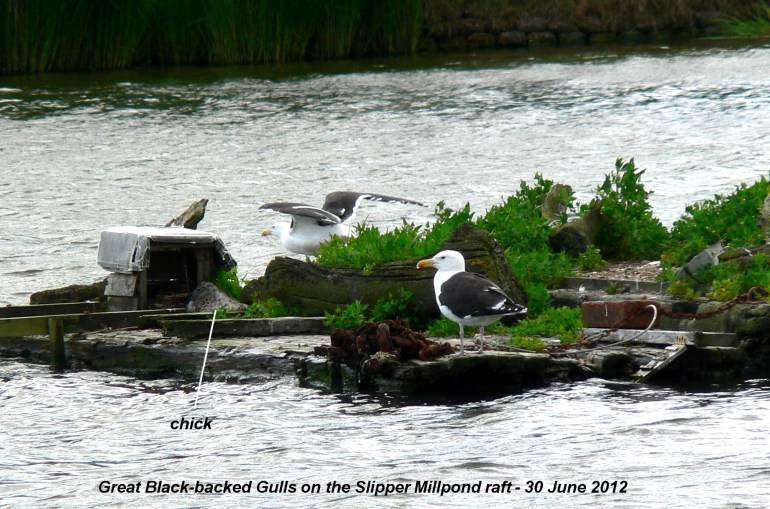
Brook
Meadow
Richard Somerscocks
had quite a good variety of butterflies on the meadow
this morning. All the usual ones were showing: Comma,
Red Admiral, Large Skipper and masses of Meadow
Browns. There were also several Ringlets on the
meadow north of Lumley Gate. These are the first
Ringlets of the year on Brook Meadow, later than last
year, but about average generally.
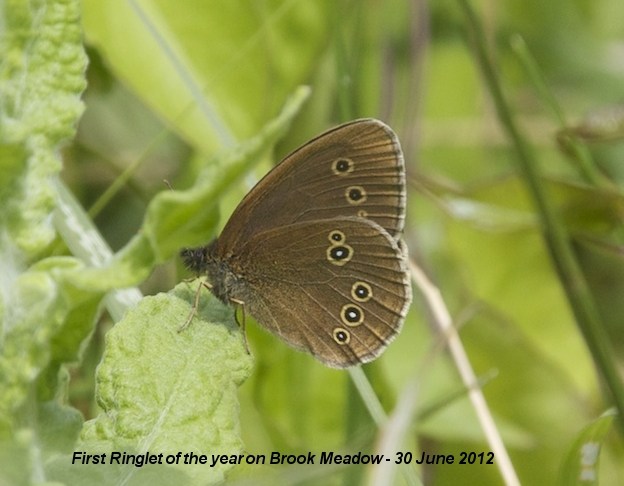
Just outside the
meadow, on the path beside Peter Pond there were a
couple Marbled Whites. I think we can claim
these for Brook Meadow too!
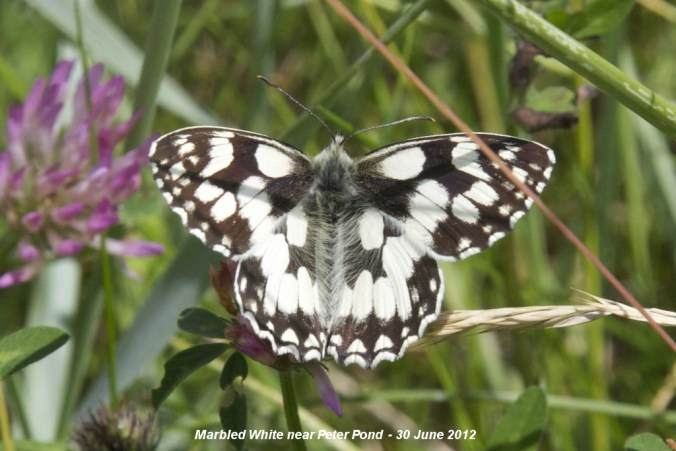
Hollybank
Woods
Richard went over to
Hollybank Woods after lunch. There was no sign of any
White Admirals yet, but there were a few
Silver-washed Fritillaries around (males).
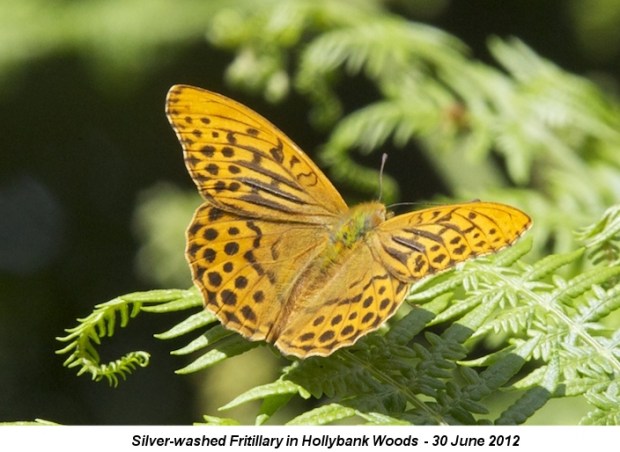
Richard also saw a
dragonfly which he thought might be a Downy
Emerald. That sounds like a rare one! I have never
seen one. Can anyone help with the ID?

FRIDAY
29 JUNE 2012
Yet
another wayside orchid
See the waysides blog
for details . . . http://www.emsworthwaysides.hampshire.org.uk/few-NEWS-2012a.htm
THURSDAY
JUNE 28 - 2012
Short-fruited
Willowherb
I sent the willowherb
specimen that I found in Hollybank Woods on June 20 to
Martin Rand for identification. I thought it might be
Marsh Willowherb (Epilobium palustre), but Martin's
verdict was that it is Short-fruited Willowherb
(Epilobium obscurum). He says, "It has dense appressed
eglandular hairs on the upper parts; glandular hairs
are confined to the hypanthium; sessile leaves running
onto the stem; and there are signs of stolons
forming". I am not disappointed since Short-fruited
Willowherb is also a new plant for the Hollybank Woods
list and for me!
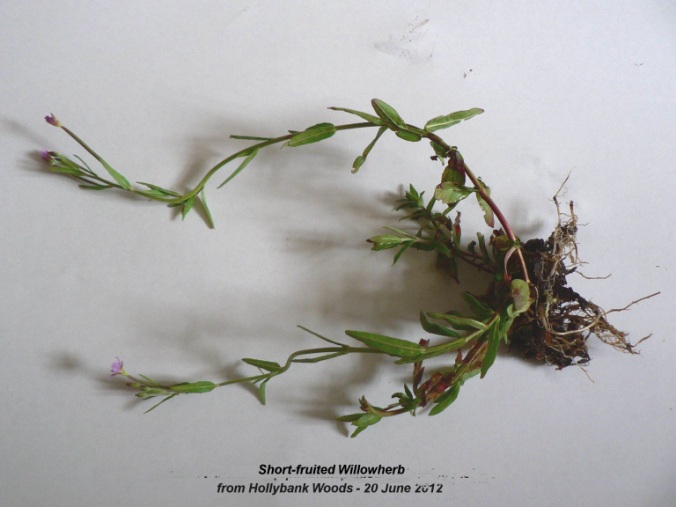
House
Sparrow recovery
BTO Garden Birdwatch
scheme reports House Sparrows numbers are approaching
a six-year high following a big drop that occurred in
the middle of last decade, especially in 2006 and
2007. This drop coincided with an outbreak of the
disease trichomonosis, which caused the death of many
Greenfinches and Chaffinches. Since 2008 a noticeable,
steady upturn in GBW counts has been recorded.
Interestingly, counts
of House Sparrows in Scottish and, particularly, Welsh
gardens are typically higher than those in English
ones. Over the longer-term, declines of House Sparrows
have been steepest in urban habitats. Within England,
House Sparrows are now seen least often in gardens in
the south east and in Greater London.
WEDNESDAY
JUNE 27 - 2012
WAYSIDES
NEWS
Christopher
Way verge
There is an excellent
crop of Smaller Cat's-tail on the eastern end
of the verge. Knotted Hedge-parsley is still
flowering on the southern edge of the verge by the
footpath.
Emsworth
Railway Station
Rosebay
Willowherb is just starting to flower in the far
corner of the site. There is a very tall Hoary
Willowherb - around 5 ft tall. I am sure it is not
Great Willowherb. No sign of any Agrimony this year,
though it is flowering on the area close to the A27
road.
SLIPPER
MILLPOND
Great
Black-backed Gulls
12:00 - The female
Great Black-backed Gull was on the raft with the two
chicks, both of which looked very healthy.

I watched one of them
flexing its wings and another chicks begging for food
from its mother. The female's face is now much whiter
and has hardly any trace of the black smudge that she
has had for a week or so.
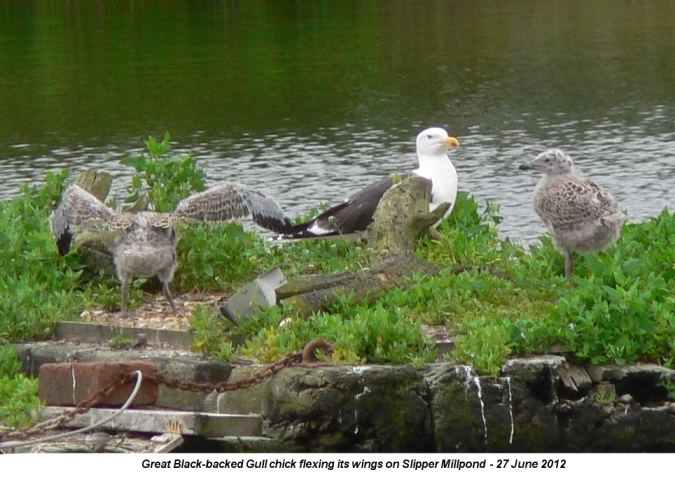
While I was there I
spotted what I thought at first was the male Great
Black-backed Gull flying in, but in fact it turned out
to be a Lesser Black-backed Gull, which flew around
the pond a couple of times before heading back to the
harbour. I have seen a Lesser here before.
When I got back from
Brook Meadow after about 1 hour I noticed the chicks
were struggling with what looked like a substantial
fish. They picked it up and nibbled it, but there was
no way they were going to be able to eat it.
Coots
The Coot nest on the
centre raft has been abandoned, which is not exactly
surprising with the two large gulls marching around on
the raft. There was no sign of the eggs which I saw
before, so they must have been taken. The two Coots
from the nest were in the water and looking perfectly
OK as if nothing had happened. That's birds for you!
The Coots are both
sitting in the nest boxes on the other two rafts. The
Coot is a also sitting on the new raft on Peter Pond.
BROOK
MEADOW
Plants in flower for
the first time included Common Knapweed in the
Lumley area (2 weeks later than last year, but that
was very early).
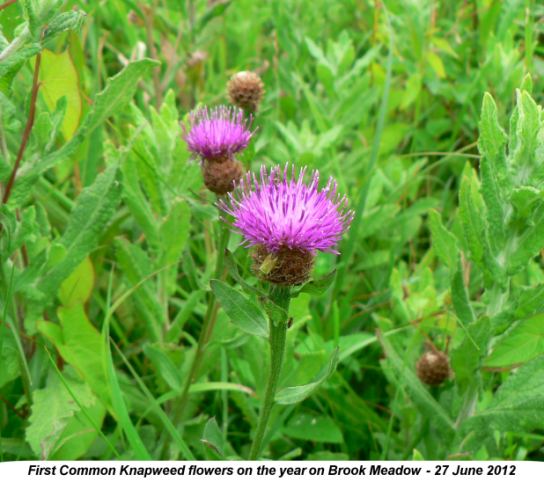
Square-stalked St
John's-wort is prominent nearby, not in flower, but
with distinctive reddish stems. Hedge Bindweed is
flowering for the first time as is Creeping Thistle.
The rushes are
flowering in the Lumley area on the western edge of
the Lumley area as they have in the past. Jointed
Rush (Juncus articulatus) and Sharp-flowered
Rush (Juncus acutiflorus) are displaying
spikelets. Sharp-flowered Rush is a much taller, more
robust plant. A good patch of Toad Rush is also in
flower in this area. I have still to find Saltmarsh
Rush and Soft Rush this year.
A Frog was jumping
around in the long grasses of the Lumley area while I
was there.
A lady and gentleman
stopped to speak, praising the meadow for its beauty
and peacefulness. I explained what a lot of hard work
had gone into the site over the years by the
conservation group and they were very appreciative.
Good work everyone!
TUESDAY
JUNE 26 - 2012
BROOK
MEADOW
I spent the afternoon
up dating the three display cases on the meadow with
recent news and photos. Birds singing included Wren,
Blackbird, Song Thrush, Chiffchaff and Blackcap.
Lesser Stitchwort is
flowering as usual on the cross path on the south
meadow. but there is no sign of either Marsh Woundwort
or Tufted Hair-grass which I have seen in recent years
at the top of the Bramble path. Thyme-leaved Speedwell
is growing on the wooden south bridge. The Giant
Fescue is looking good on the river bank below the
south bridge, but not in flower.
BRIDGE
ROAD WAYSIDE
Narrow-leaved
Water-plantain - Alisma lanceolata - is flowering
again with its distinctive three rounded white-pink
petals in among the Bulrushes on the east bank of the
Westbrook Stream. I had feared the plants would have
been washed away in the floods, but clearly some have
survived.
Another plant to have
survived the flood is Sulphur Cinquefoil which
is still in full flower on the southern verge.
Hoary
Willowherb is also in flower on the edge of the
verge opposite the middle of the central shrubbery.
Slender Speedwell is still flowering on the
main grass verge. It has been in flower since early
spring.
There are at least
three areas of False Brome grass, like False
Brome but without the long branches on the spikelets.
Meanwhile,
Herb-Robert has its very attractive fruits,
slightly ridged and red and hairy with a long tapering
'beak'.
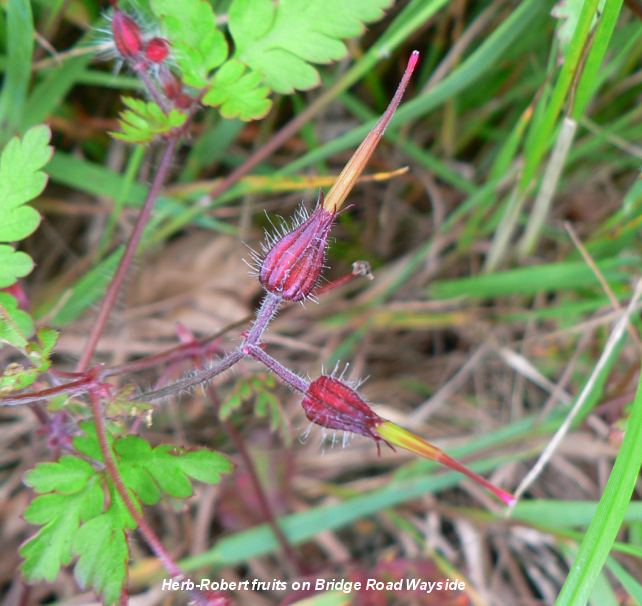
SATURDAY
JUNE 23 - 2012
Great
Black-backed Gulls
I checked Slipper
Millpond at about 5pm. Both gulls were on the centre
raft along with a juvenile Cormorant. The gulls seem
to be fairly tolerant of Cormorants, but apparently
not Grey Herons. The gulls seemed to take no interest
in the Cormorant.
The male and female
gulls are easier to distinguish now, as the female has
a dark smudge on its face which it must have picked up
while feeding. As I was watching them from Slipper
Road the male gull flew up and over my head making
soft croaking noises, which I have previously
interpreted as 'buzzing'.
I could only see one
of the chicks, but while I was there it was flexing
its wings which clearly are growing stronger by the
day, though I do not expect to see fledging before the
end of July - 55-60 days after hatching.
The Coot remains
entrenched in the nest box.
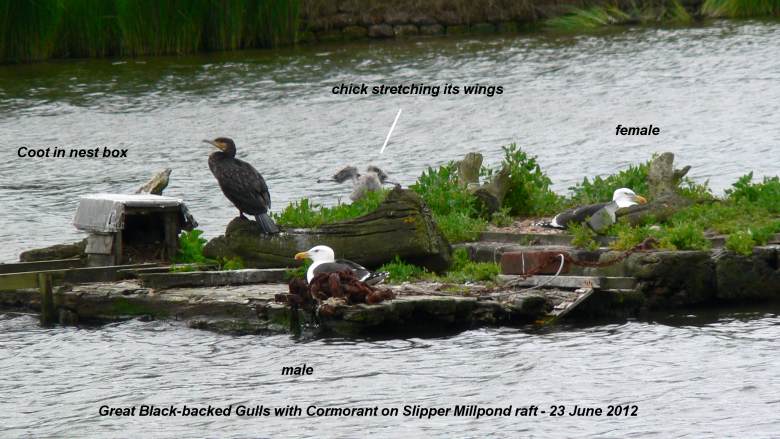
Fort
Widley
Jean and I had a walk
around Fort Widley this afternoon, mainly to look for
orchids. We found a few Common Spotteds at the back of
the fort and a good number of Pyramidal Orchids on the
path in front of the fort, but not so many as I recall
seeing in some previous years.
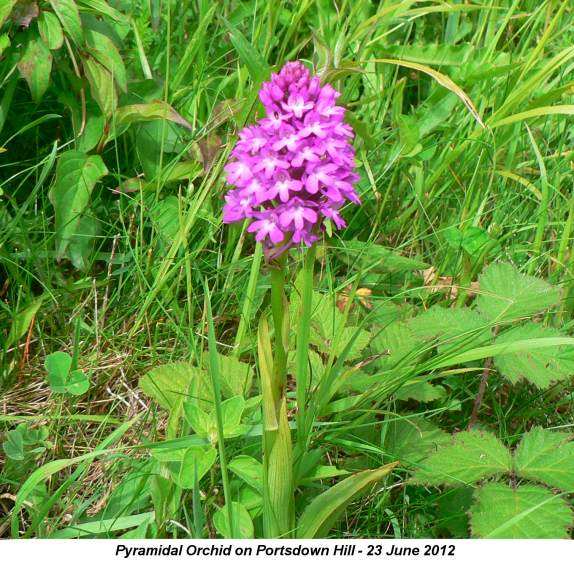
Other flowers seen
included Greater Knapweed, Kidney Vetch, Tufted Vetch,
Agrimony, Viper's Bugloss, Quaking Grass, Oxeye Daisy,
Hedge Bedstraw, Crosswort and a few Restharrow. There
were lots of yellow daisies with very rough stems -
Rough Hawkbit? One Red Admiral was the only butterfly
seen.
Brook
Meadow
Richard Somerscocks
was on Brook Meadow at lunch today. He saw the usual
assortment of butterflies: Holly Blue, Red Admiral,
Comma, Large Skipper, and plenty of Meadow Browns.
Quite a few Banded Demoiselles, but only a single
Azure Damselfly.
Moths included a
Small Magpie Moth - which I think is a first
for Brook Meadow. What a beauty.
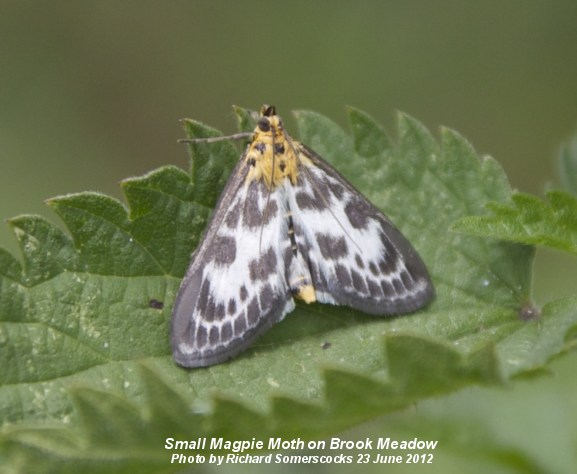
Richard also found the
first Bee Orchid on the meadow this year just
north of the Lumley Gate. Same area as last year, but
slightly closer to the gate. Richard put a stick in to
mark the spot, but says it is still fairly difficult
to see in the long grass.
FRIDAY
JUNE 22 - 2012
WAYSIDES
NEWS
Bee
Orchid
I did a tour round
some of the local waysides this morning and was
rewarded with some good finds. The best was the very
first wayside Bee Orchid on the New Brighton Road
Junction. The plant has one flower open at the top and
several other buds yet to open. Maybe this is the
first of many?
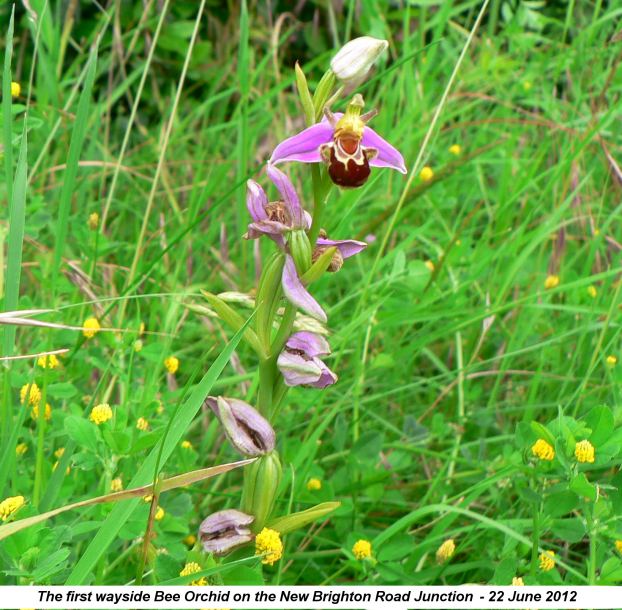
Creeping
Bent-grass
The area behind the
bowling club in Emsworth Recreation Ground is
definitely my favourite waysides grassland. The area
is dominated by the pink panicles of Yorkshire Fog
waving around in the breeze, with Timothy growing well
and the first of Creeping Bent-grass showing its
delicate scarlet inflorescences. A really beautiful
grass.
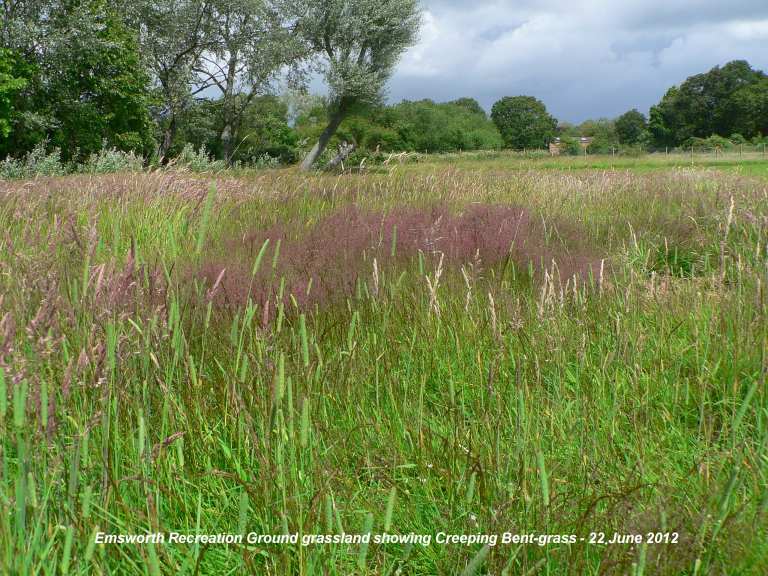
Hairy
Buttercups and Toad Rush
I found a really
interesting selection of plants growing along the wet
track to the main gate in the north-east corner of the
Recreation Ground including Hairy Buttercups, which I
confirmed by pulling up one small plant which had no
bulb and a number of clumps of Toad Rush -
another waysides first.
OTHER
NEWS
Bar-headed
Goose
Eric Eddles had a
great surprise when a Bar-headed Goose turned up on
Baffins Pond yesterday. The bird has rings on both
legs, with a plain green ring on the left leg and a
metal ring with number and letter engravings on the
right. The right leg ring is presumably the standard
British Museum Ring.
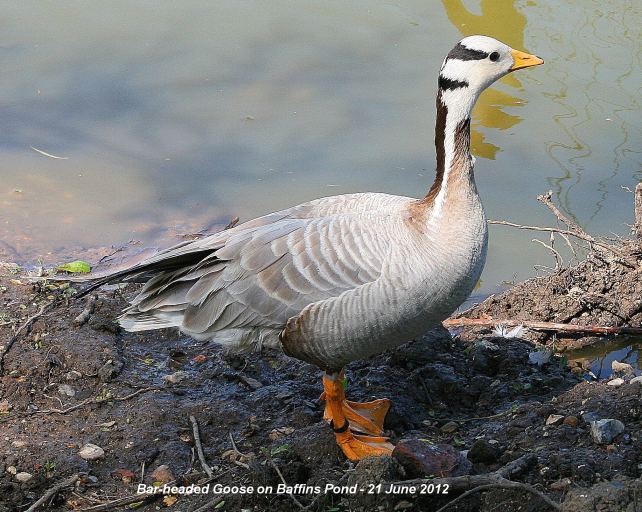
I regularly used to
get a Bar-headed Goose in the 1990s on Baffins Pond
along with the Barnacle Geese and Snow Geese - all
part of the now extinct 'Baffins Gang' that used to
move between Baffins Pond and Titchfield Haven. The
Bar-headed Goose that I used to see was not ringed.
House
Martins
Paul Cooper who lives
in Funtington was interested to read the report about
the complete absence of House Martin nests on Stansted
House. He says, "Our martins repaired their nest on
our house and other pairs returned to three or four
neighbours' houses. Then, about four weeks ago, they
disappeared. We do occasionally see four or five
flying very high above the house (where previously we
might see a dozen) but they do not come anywhere near
the nest. A friend with a cottage on the Quantocks has
a thriving family of House Martins nesting, so it
doesn't seem to be a problem everywhere, and I
wouldn't have thought they have many predators, if
any. I wonder what has happened. Has the cold weather
reduced the supply of insects so they haven't
mated?"
That would seem a very
likely answer. The weather has been exceptionally wet
and cold this spring. This has also affected the
Swifts which have not turned up in Emsworth or Havant
in any numbers.
THURSDAY
JUNE 21 - 2012
Slipper
Millpond
16:00 - The two adult
Great Black-backed Gulls were changing over chick
minding duties as I arrived. The female flew off to
the harbour while the male remained on the raft. The
two chicks are now growing fast and looking healthy.

Brook
Meadow
A Banded Demoiselle
was flying in the south eastern corner of the south
meadow. There is a good flowering of Bittersweet in
this area. Lungwort is flowering on the Seagull Lane
patch at the far end of the new Jubilee hedgerow.
Stone Parsley is still present at the northern end of
the Seagull Lane patch. Watercress and Water Figwort
are both in flower on the north bend of the river.
Marsh
Willowherb (Epilobium palustre)
NOTE
-
Martin Rand
subsequently identified this plant as Short-fruited
Willowherb (Epilobium obscurum). See June 28.
I think the Willowherb
plants that I found flowering on the newly cleared
area (Jubilee Hedgerow area) of Hollybank Woods
yesterday (20 June 2012) are Marsh Willowherb
(Epilobium palustre). The plants were not in a
noticeably wet area though the woodland has several
small streams running through it.
The following
characteristics seem to support this identification.
1. Relatively short
and slender plants with a small pink flower at the top
of the stem.
2. A small flower
about 10mm across with a club shaped stigma.
3. Stem is round and
hairy without any grooves.
4. Leaves are
stalkless and narrow, tapering at both ends.
5. The stolons are
thread-like - as indicated by Kitchener in his paper
on Willowherb ID. Here is a close up of the stolons.
I recall finding what
I thought might be Marsh Willowherb on the eastern
bridleway in Hollybank Woods on 6 and 20 Sep 2005.
However, on advice from Ralph Hollins I decided not to
formally record this as a Hollybank species. I believe
the case for the present plants is stronger.
Greenshank
sighting
Pete Potts reports
Greenshank NY+GR ringed on 23Sept06 has been seen and
photographed breeding in Sutherland, north Scotland
this week! This is the first ever link with this
breeding population and The Solent. He wants to know
if anyone has seen this bird at any stage in the last
6 years. A great record indeed not what we expected!
I have had 18
sightings of NY+GR in Emsworth Harbour from 27-Nov-06
to 25-Nov-09. But not seen since.
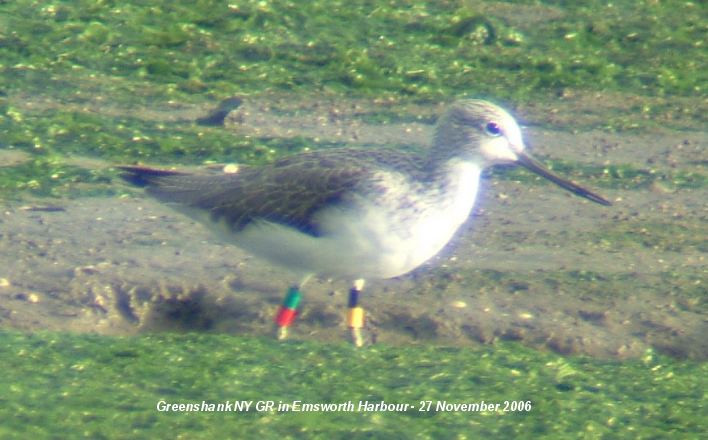
WEDNESDAY
JUNE 20 - 2012
EMSWORTH
Swifts
For the second day
running four Swifts have been flying low around the
houses in Bridge Road. This is the first time we have
seen then regularly throughout the day. This is
probably a family group doing some social bonding. So,
maybe they have nested somewhere local? I suspect they
won't be here tomorrow when yet more heavy rain is
forecast.
Great
Black-backed Gulls
I checked Slipper
Millpond at 5pm. The female Great Black-backed Gull
was standing on the centre raft with its two chicks
lying down nearby. While I was there the Coots changed
over brooding duties in the nest box, with one Coot
coming onto the raft to relieve the sitting Coot. I
could just make out 2 or possibly 3 eggs in the box.
The adult gull took absolutely no notice of this
change over at all.
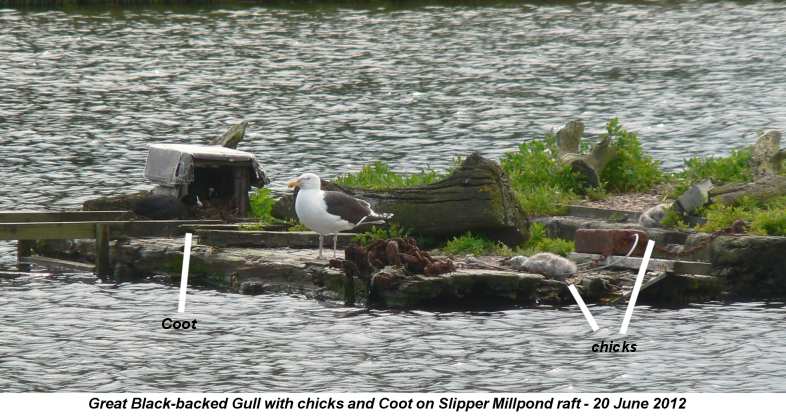
HOLLYBANK
WOODS
It was a lovely warm
morning for a walk through this beautiful woodland. I
met Andy Brook and his team of conservation volunteers
working hard clearing the bracken from the recently
cleared area west of the old Holly Lodge clearing. The
volunteers are also learning old woodland skills like
coppicing and splitting of logs.
Heath
Wood-rush
The best find of the
morning was a new site for Heath Wood-rushes in the
southern Bluebell area about 20 metres to the east of
the Wild Cherry tree. These plants were surprisingly
abundant in this small area (100+) in amongst the
Bracken and were certainly the best I have ever seen
in Hollybank Woods.
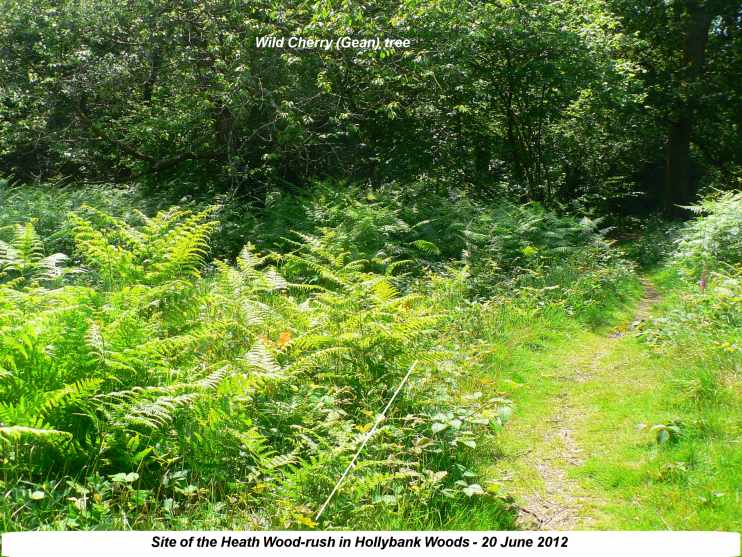
I think most of the
plants were Heath Wood-rush (Luzula
multiflora ssp. multiflora) which I have not
recorded in Hollybank Woods before. They have an
umbel-like inflorescence at the top of a tall stem (up
to 40 cm - which probably rules out Field Wood-rush)
made up of around 10 flower heads on slender branches
and a lower bract that does not overtop the
inflorescence. PS - I shall need to get this
identification checked by Martin Rand.
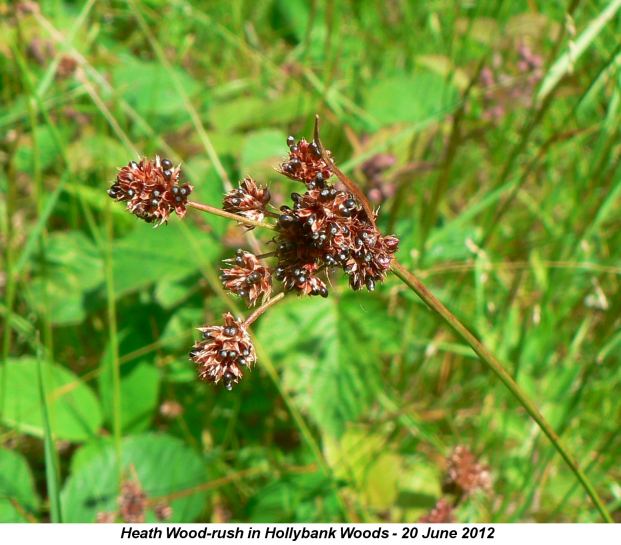
There were also some
examples of Dense-headed Heath Wood-rush
(Luzula multiflora ssp congesta) which I have
recorded each year along this path, but not in this
particular location. Dense-headed Heath Wood-rush was
originally discovered in this area by the late Gwynne
Johnson on 11-May 2002. This plant is quite different
from Heath Wood-rush in having a single rounded
cluster of flower heads with the lower bract longer
than the inflorescence. There appeared to be many
intermediate examples between these two species -
possible hybrids?
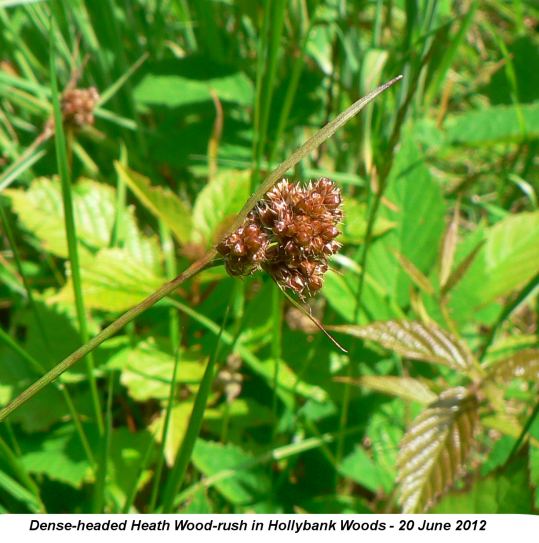
Other
plants
Other plants of
interest included Quaking Grass along the main track,
Creeping Bent-grass with panicles still closed, Wood
Millet along the south east path, Remote Sedge, Wood
Sedge. Soft Rush and Compact Rush. Lesser Stitchwort
and Crosswort were showing well in the old Holly Lodge
clearing along with lots of other common flowers. I
noticed several Broad-leaved Willowherb type plants
were flowering on the newly cleared area. They were
short and thin with narrow leaves and a small flower
at the top of the stem. I also found some Heath
Speedwell in flower in this area.
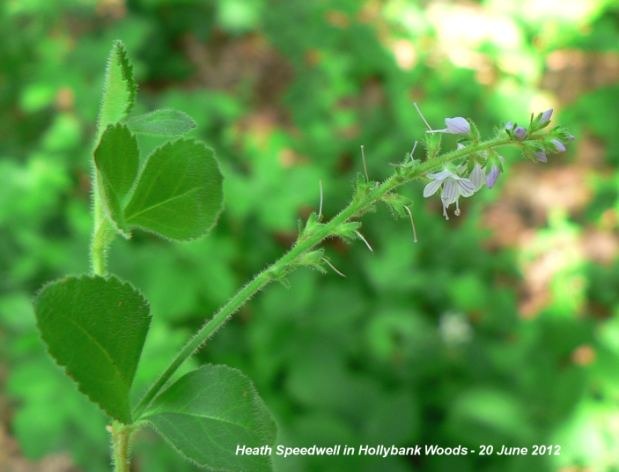
Birds
Birds were generally
quiet. I heard several Blackcaps and a couple of
Chiffchaffs. Others singing included Wren and Stock
Dove with Buzzard calling overhead.
Butterflies
Butterflies were very
scarce. I saw 2 Speckled Woods, 2 Red Admirals and
three Meadow Browns. I looked everywhere for White
Admiral, but did not see any, not even from my
favourite seat on the western bridleway.

TUESDAY
JUNE 19 - 2012
EMSWORTH
Great
Black-backed Gulls
17:00 - The two Great
Black-backed Gull chicks were on their own on the
centre raft on Slipper Millpond when I checked this
afternoon. However, one of the parents was close by on
the water, keeping an eye on them. They looked in good
health.
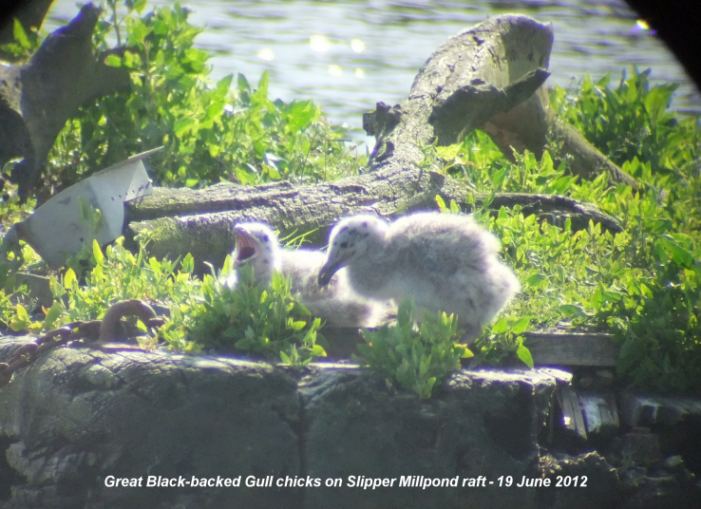
Swifts
Several Swifts were
flying around the houses in Bridge Road at various
times today, but not in any determined fashion, almost
as if they were just passing through.
Cuckoo
Richard Somerscocks
spotted this Cuckoo which came to rest for a short
while on the Willow by the Lumley Gate.

MONDAY
JUNE 18 - 2012
WAYSIDES
SURVEYS
Jane Brook and I did
our Monday morning survey of the waysides in North
Emsworth.
Southleigh Road (west)
- We found several plants flowering on the traffic
island at the eastern end of Southleigh Road,
including Selfheal, Buckshorn Plantain, Smooth
Hawk's-beard, Lesser Trefoil. Hemlock was in full
flower on the main verge with lots of Stone Parsley
yet to flower.
I was particularly
pleased to discover a good growth of False Brome with
lush green leaves Just past the entrance to Southleigh
Farm we found a Wild Carrot in the early stages of
growth.
One Meadow Brown was
on the vegetation and several nests of 'Nursery-web
spider' (Pisaura mirabilis).
Spencer's Field verge
- The grasses were high and very lush on this enclosed
wayside. The first Common Ragwort was flowering. Three
Meadow Browns came up from the grasses.
Greville Green (west)
- A very good patch of Bird's-foot Trefoil was in
flower. The sole Common Spotted Orchid was in flower
and looking quite good.
EMSWORTH
Slipper
Millpond
I checked on the Great
Black-backed Gulls at 5pm. One adult was on the raft
with the two chciks. The adult flew off while I was
there, leaving the chicks on their own, returning
about 15 minutes later. This shows their growing
confidence in the chicks.
The Coot is still in
the nest box on the gull raft. Coots are also esconsed
in the nest boxes on the northern and southern rafts.
Peter
Pond
The Coot is on the
nest on the new raft. Crow Garlic bulbils are now
showing on the east bank of the pond. Rough Chervil is
flowering on the west bank of the pond opposite
Gooseberry Cottage.
OTHER
NEWS
House
Martins absent
Ralph Hollins reports
that Laurence Holloway made an annual trip on June 15
from Bognor to count the House Martin nests on
Stansted House, but found no nests at all for the
first time. Ralph says in Havant, although none nest
nowadays on houses close to his, he usually sees what
he assumes are local breeders feeding over the trees
lining the old rail line at the back of his garden.
But, so far this year he has seen none bar a couple of
individuals making a bee line for Budds Farm.
SATURDAY
JUNE 16 - 2012
EMSWORTH
Slipper
Millpond
14:00 - Another very
windy day on the pond. The male Great Black-backed
Gull was on the centre raft along with both chicks
which were moving around and looking healthy.

Janet and Richard
Baker saw some excitement on the pond this evening
when another black-backed gull, with feathers missing
from each wing, swooped over the central raft. The
resident gulls were much disturbed by this intrusion
and saw the intruder off, but this is a warning to
them not to get too complacent!
This afternoon,
Richard Somerscocks spotted a Sandwich Tern
fishing in the pond.

Brook
Meadow
Richard Somerscocks
saw another Large Skipper on Brook Meadow this
afternoon and also a couple of Meadow Browns.
These were the first seen on Brook Meadow this year, a
bit later than year.
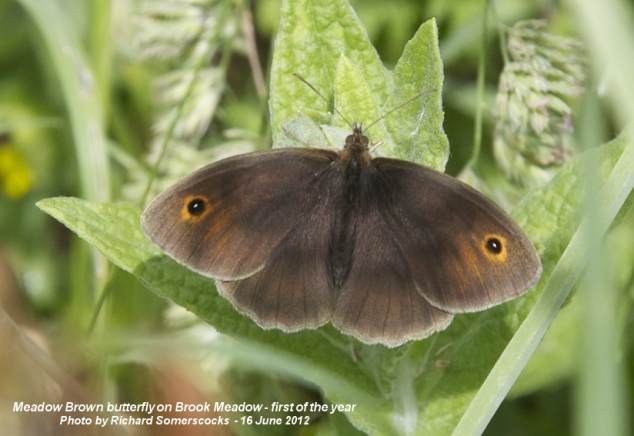
Damselflies included
Large Red, Blue Tailed and Azure. There were also
several Banded Demoiselles. Lots of young birds were
on the Meadow and Richard got a nice shot of some Long
Tailed Tits.
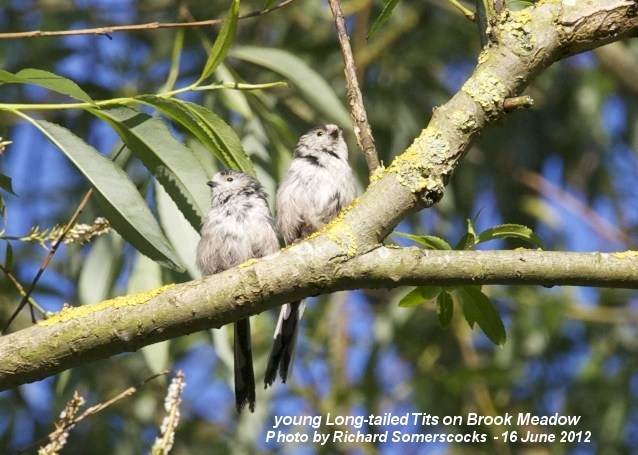
Malcolm Phillips was
on the meadow for about an hour this morning and saw
some Brown Trout in the river.
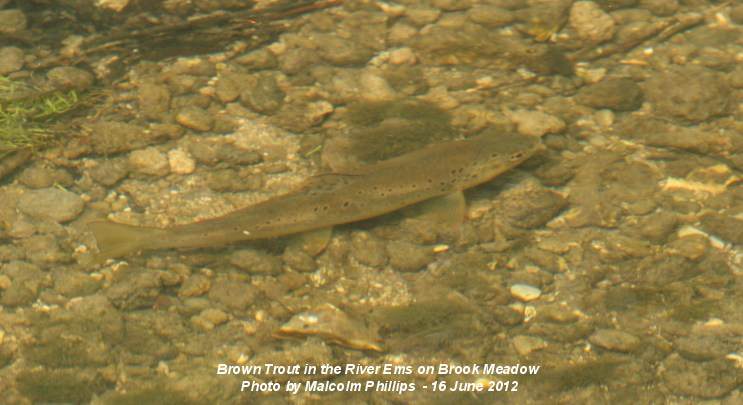
WAYSIDES
NEWS
Christopher
Way verge
The grasses of the
verge were looking magnificent, mainly False
Oat-grass, Cocksfoot, Barren Brome, Wall Barley and
Red Fescue. I was pleased to find my first Creeping
Bent-grass of the year with panicles typically
closed up. Some of the spikelets had awns - Rose says
they are usually awnless. I also found Smaller
Cat's-tail on the eastern end of the verge as last
year. The spikelets are small with short awns and the
ligule is pointed, but I shall need to check later
just in case it develops into Timothy. Crested
Dog's-tail was a new grass for this site.
The Knotted
Hedge-parsley is again flowering very well on the
southern edge of the verge by the footpath as is the
Wild Clary. The Wild Clary were not easy to count, but
I would estimate a good 40 plants, which is what I
counted last year.
Westbourne
Open Space
As usual this wayside
has a glorious display of grasses swaying in the stiff
breeze. Meadow Foxtail remains the dominant grass
though its spikelets are beginning to wear thin.
I had my first
Field Bindweed flowers of the year near the
northern edge of the site.

We seem to have lost
all the Knotted Hedge-parsley which was growing
profusely along the edge of the footpath. The only
plants I could find were growing under the hedge to
the south of the main site. Amphibious Bistort is
coming up again on the eastern side of the wayside -
unusual in such a dry site.
PORTSDOWN
HILL
Caroline French
reported on this morng's walk by the Havant Wildlife
Group.
Report on the
Havant
Wildlife Group page
for the report . . .
FRIDAY JUNE 15 - 2012
EMSWORTH
Great
Black-backed Gull family
10:30 - The strong SW
wind was whipping up the waves on the pond this
morning. The female was on the raft on Slipper
Millpond. I could see one of the chicks moving around.
I suspect the other was snuggled down in the
vegetation.
Late
Cuckoo?
I met Sid Davies who
had just come back from North Thorney where he heard
and saw a Cuckoo along the old ERA track. He wondered
if this was a bit late for a Cuckoo to be calling. I
checked with the Birds of the Western Palearctic which
indicated the Cuckoo breeding season extended through
June and into July, so I suppose it would not be
unexpected to hear one calling in mid-June. Migration
is well underway by August.
WAYSIDES
NEWS
Warblington
Underpass
I did a survey of this
wayside this morning. I found the following new plants
Hemlock, White Clover, Buckshorn Plantain,
Goat's-beard, Crested Dog's-tail, English Elm, Field
Maple and Squirrel-tail Fescue (see below). These take
the grand total for this wayside to 128 with 93
species having been seen so far this year. I looked
for, but did not find the Clustered Clover that John
Norton found here on his visit on June 4. Rough
Chervil is flowering on the main wayside as in
previous years.
I saw my first
'thigh beetle' (Oedemera nobilis) of the year
was feeding on Cat's-ear.

Squirrel-tail
Fescue (Vulpia bromides).
This was a new plant
for the waysides and for me! I discovered it along the
track leading to the pressure reducing station at the
western end of the wayside. It stood out as a very
fine green stems and long awns. Very different.
Squirrel-tail Fescue
is native plant and an annual (unlike the more common
fescues) and grows on sandy ground, walls and waste
ground. It is distinguished from the similar
Rat's-tail Fescue by the distance between the
inflorescence and the inflated leaf sheaths. It is
described as locally common in The Hants Flora.
THURSDAY
JUNE 14 - 2012
EMSWORTH
Great
Black-backed Gull family
10:00 - All is well.
Both adult gulls were snoozing on the centre raft on
Slipper Millpond. The male gull was actually on top of
the Coot nest box with the Coot inside! I could not
see the chicks but I suspect they too were snoozing
somewhere.
BROOK
MEADOW
An Opium Poppy flower
was showing above the mass of vegetation on the
Seagull Lane patch, just to the west of Jenny's Oak
tree. It has been there in previous years.
I was surprised at the
large amount of Meadow Foxtail still in flower on the
meadow. Timothy has not yet come into its own.
I discovered a number
of plants of Smooth Brome (Bromus racemosus)
(a meadow indicator species) on the path around
the Lumley area and on the Bramble path much as I did
last year. Smooth Brome can be distinguished from the
very similar Soft Brome (Bromus hordeaceus) by its
longer panicles, usually around 15cm.
A Demoiselle damselfly
on the Bramble path did not settle, but was dark
enough to suggest Beautiful Demoiselle. We have
already had one of these photographed on Brook Meadow
this spring.
I found Black
Bryony clambering over the shrubs in the
north-east corner of Palmer's Road Car Park behind the
bottle bank. Not quite flowering. This is a new plant
taking the Brook Meadow list to 225 herbs and a grand
total of 339
WEDNESDAY
JUNE 13 - 2012
EMSWORTH
Great
Black-backed Gull family
12.30 - Both the adult
Great Black-backed Gulls were on the centre raft along
with the two remaining chicks. The chicks are looking
healthy and were moving around the raft. At one point
they were fed by the male. Here is one of the chicks.

The female spent some
time collecting small twigs and bits of dead
vegetation for the nest. At one point, she raided the
Coot nest and removed some of the barricade of twigs;
the Coot did not stir. I was buzzed again briefly
while standing on Slipper Road by the male. All three
nest boxes on the rafts are still occupied by Coot
sitting on nests, including the one on the gull raft.
NUTBOURNE
Mystery
Pipit
Peter Adeline was
puzzled by a bird he saw at Nutbourne this morning. He
was pretty sure it was a pipit, large like a Rock
Pipit, but very speckled and distinctly creamy-yellow
and very pert, long-legged, thin-billed. It was on the
track below the sea-wall path between Prinstead and
Nutbourne marshes. It scurried into the long grass and
hid. It flew with a fluttery erratic flight, showing a
creamy-white rump, then went into the grass again, not
seen further.
Not having seen the
bird my first inclination was to go for Meadow Pipit,
which is a common bird in that area. But Peter insists
it was not a Meadow Pipit. He thought Tawny would be
closer in appearance, but it wasn't that either. Has
anyone got any ideas? Sorry no photo.
TUESDAY
JUNE 12 - 2012
EMSWORTH
Great
Black-backed Gulls
12:30 - I was relieved
to find both Great Black-backed Gull chicks moving
around on the centre raft when I checked this
morning.
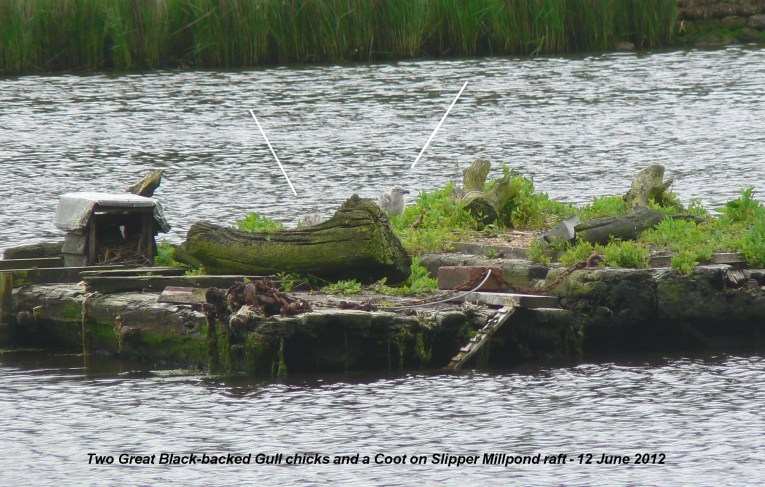
Clearly, they had
survived the awful weather conditions of yesterday.
The two adults were also on the pond, one just having
returned with some food for the chicks. As I was
watching the nest with my scope from the Hermitage
Bridge one of the adult birds flew over my head a few
times, clearly unhappy with my presence, though I was
a good 50 metres from the nest. The gull finally
settled on the pond in front of me where I took the
following photo. This is the second time I have been
'buzzed' by one of the adult gulls.
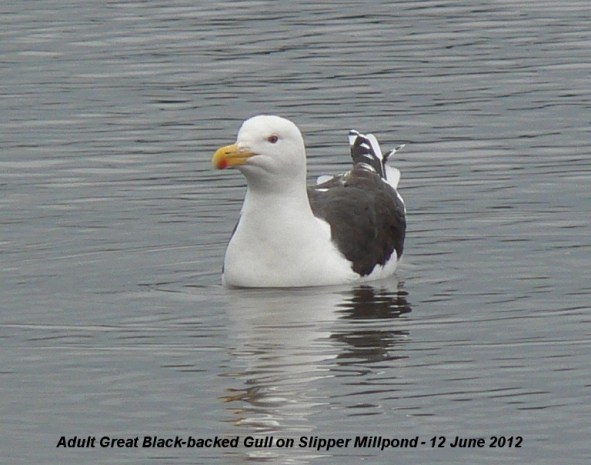
Coots
The Coot is still
ensconced in the nest box on the same raft as the
gulls. I think the Coots are also present in the other
two nest boxes for second broods.
A Coot is also nesting
on the new floating raft in the centre of Peter Pond.
Brook
Meadow flowers
The first white
flowers of Large Bindweed were showing on the Seagull
Lane patch. I also found a good growth of Slender
Speedwell in the recently cleared area on the
Seagull Lane patch.
I found a cluster of 7
flowering spikes of Common Spotted Orchids on
the north path of the orchid area - an increase of 4
over last year. These are about 20 metres west of the
large Crack Willow tree near the small seat on the
north east path. I cleared some of the tall grasses
around the flowers to give them a better chance. I
looked for more spikes in the usual places, but the
grasses are far too dense and tall.
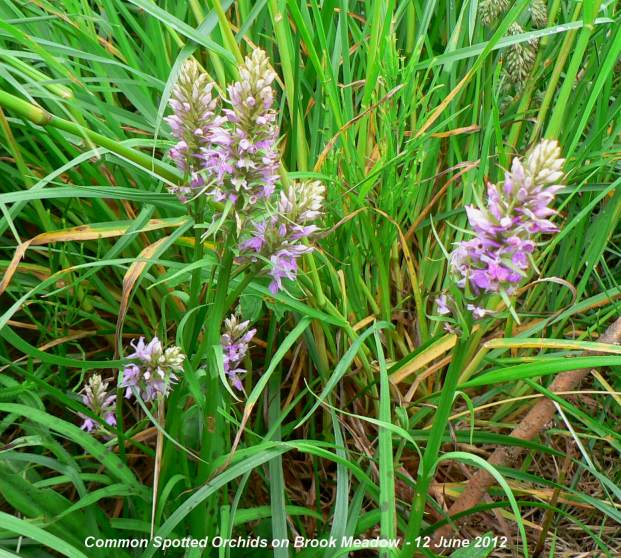
The Southern Marsh
Orchids are looking splendid - 9 of them in the same
area as last year. I looked in vain for the 10th which
I have previously seen to the south of main plants.
Waysides
News
I had a quick walk
along the Dolphin Creek path where I found Lesser
Swine-cress, Thyme-leaved Speedwell and Wall Barley.
The latter two were new plants for this wayside taking
the grand total to 74.
The Honeysuckle on the
Lillywhite's path is now flowering with pairs of
purple tinged pale yellow flowers characteristic of
Japanese Honeysuckle, not the native one.
Japanese Honeysuckle has black berries, whereas the
native Honeysuckle has red berries.
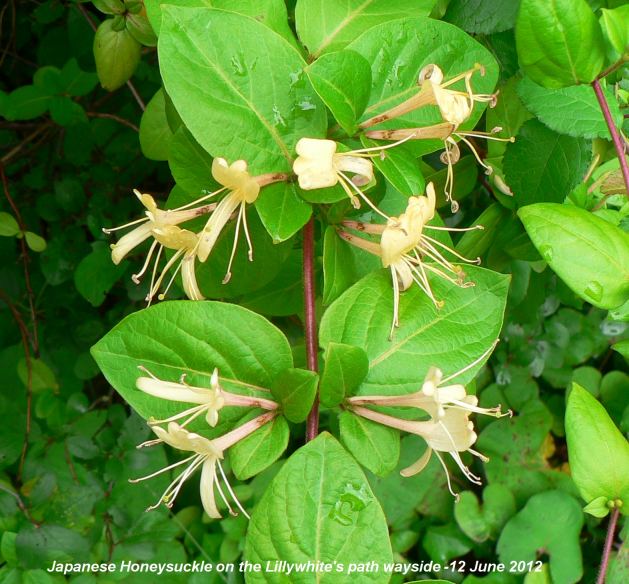
MONDAY
JUNE 11 - 2012
Westbrook
Stream flood
Here are a few photos
taken during the flooding of the Westbrook Stream
today. The rain was heavy and continuous all morning
and much of the afternoon, which meant that the
Westbrook Stream became a raging torrent. Here is it
racing through the Bridge Road Wayside.
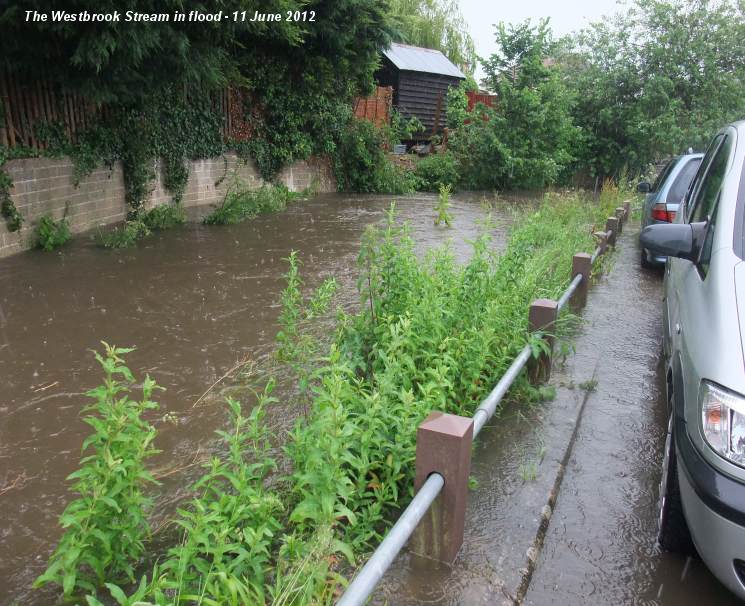
I was surprised to
find the flowers of Sulphur Cinquefoil still intact
despite the flood.

The stream quickly
broke its banks and flooded the car park.

The flooding in the
southern part of Bridge Road was not as bad as it was
in Nov 2010, but the road had to be closed and
sandbags issued. I believe some houses were flooded.
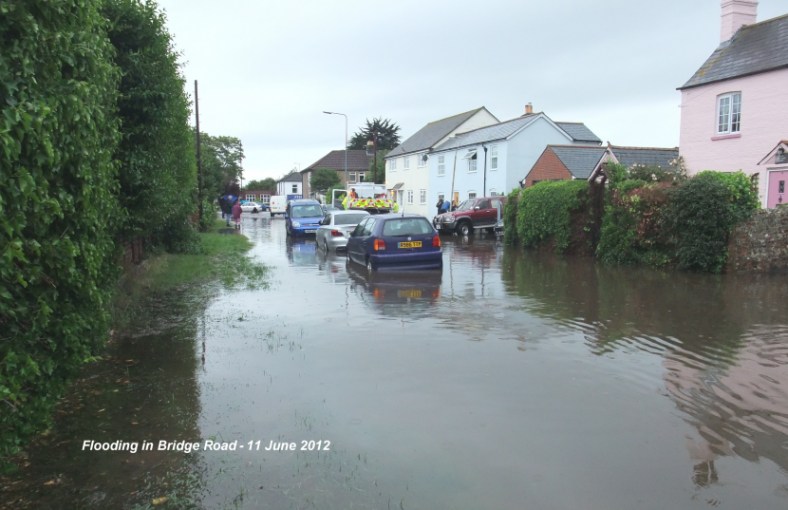
The flooding in
Victoria Road where the Westbrook Stream flows under
the road was much worse than last time. In fact,
locals said they had never seen the stream as high.
Several houses were flooded and the road closed.
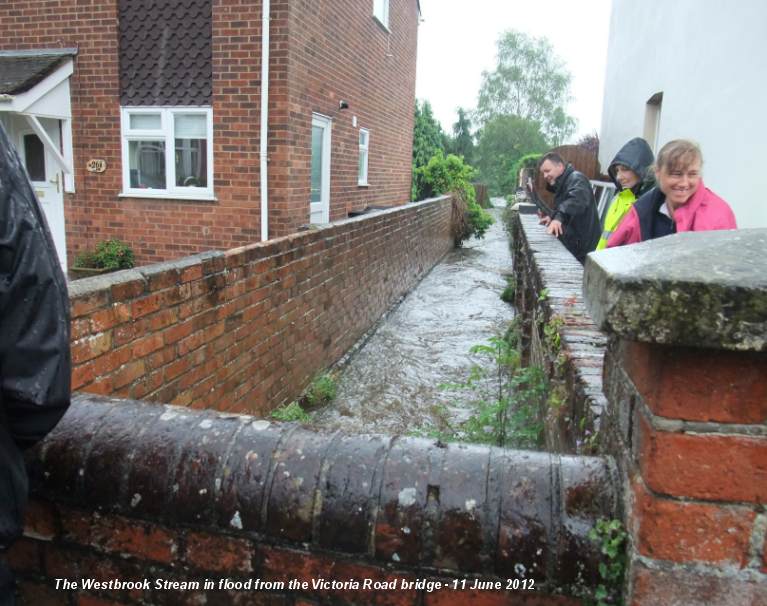
Our garden which backs
onto the stream progressively flooded during the day,
but the house was not threatened.

SUNDAY
JUNE 10 - 2012
BROOK
MEADOW
Plant
news
Hedge Woundwort was
flowering by the Weeping Willow tree at the top of the
Bramble path where Marsh Woundwort often flowers. No
sign of the latter. Oxeye Daisies are now flowering on
the east side of the orchid area on the north meadow.
All the Ragged
Robin appear to have gone from the Lumley area. I
did not get around to doing a proper count this year,
but number could not have been more than 20. This is
the lowest count ever. See Brook Meadow web site for
full details on Plant List page.
There is a good growth
of Meadow Fescue at the south end of the north
west path. Timothy is now flowering widely on the
meadow. Hard Rush is flowering in the Lumley area, but
no sign of Sharp-flowered Rush.
Nuthatch
family
We have had several
sightings of Nuthatches along the north path by the
railway embankment and have wondered whether they were
nesting somewhere in the area. Well this afternoon,
Richard Somerscocks happened to see a family of 4
Nuthatches beside the north path He thought there
could have been more but they were very difficult to
count as they moved through the fairly dense foliage.
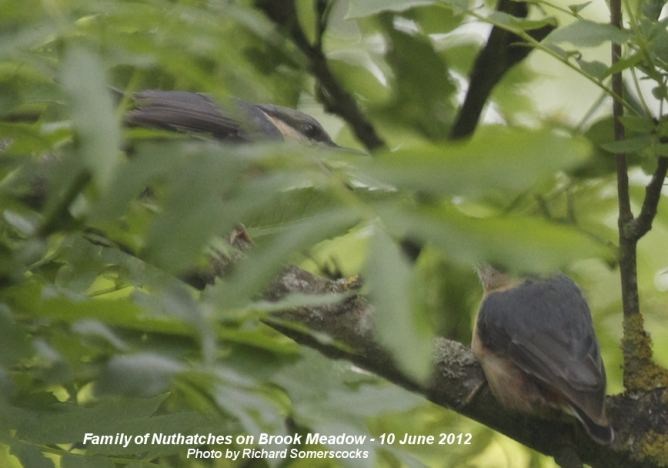
SLIPPER
MILLPOND
Great
Black-backed Gull chicks
10:00 - I checked the
centre raft on Slipper Millpond this morning and an
adult was on the raft along with two surviving
youngsters, both moving around and looking healthy.
OTHER
NEWS
Grasses
I confirmed that Water
Bent and Fern Grass are growing on the driveway of
number 35 St James Road. These were discovered during
the visit of John Norton and Eric Clement to Emsworth
on Monday June 4.
Yellow Oat-grass is
flourishing along the edge of the millpond along Bath
Road, where the mowers did not cut close to the pond
edge.
Fox
in garden
The first thing I saw
when I came down this morning was a fully grown Fox on
the grass in the garden. He was munching away at the
small pile of chopped nuts and seeds that the
grandchildren had put out yesterday. That was a first
for the garden.
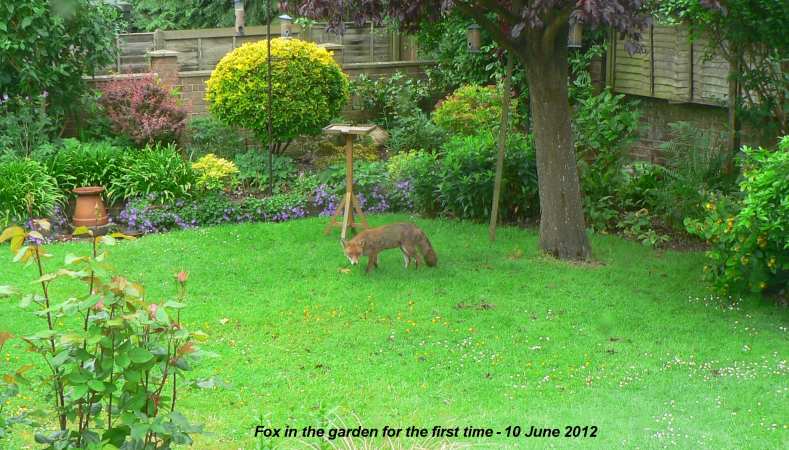
Bullfinches
in garden
As previously noted in
this blog, I have had the pleasure a pair of
Bullfinches visiting my garden feeders on two
occasions in the past week. Terry Lifton who lives in
Westbourne Avenue e-mailed to say that she too has had
a pair of Bullfinches in her garden for the first time
ever. It is not impossible that they are the same pair
that I had, though I would have thought there must be
more than one pair roaming the area at present after
the end of breeding. Here is Terry's photo of the
male.
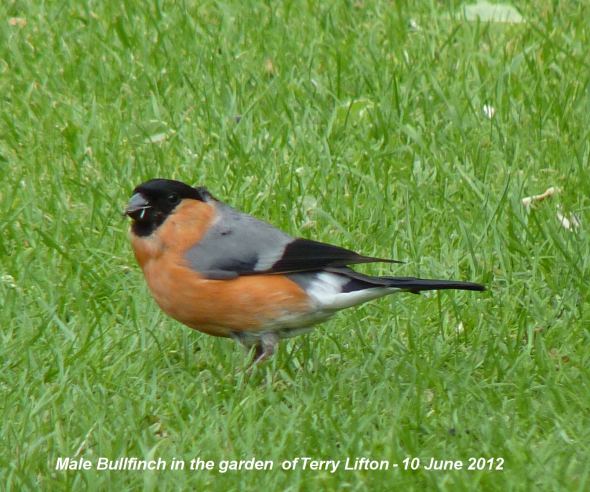
FARLINGTON
MARSHES
With his 5 week old
son waking us up at 4:40am, Peter Milinets-Raby
decided to get up and go down Farlington Marshes for a
couple of hours and had the place to himself until
7am. The bird highlight was a Glossy Ibis on
the small pool by the information hut.
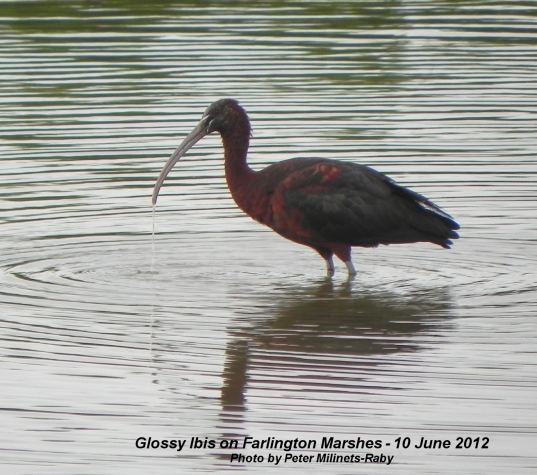
Peter also has a short
video of it on YouTube . . . http://youtu.be/xyZEffvM8Wc
Other highlights were
Black Tern on the main lake at 5am for 20 minutes
along with 12 Little Egrets and 3 Med Gulls. Elsewhere
around the reserve were Cetti's Warbler 2+, Lesser
Whitethroat 1, Bearded Tit 2, Black-tailed Godwit 2,
Buzzard, Cuckoo, Rock Pipit 2, plus usual warblers.
SATURDAY
JUNE 8 - 2012
PORTSDOWN
HILL
Ros Norton reported on
this morning's walk by the Havant Wildlife Group.
There were 8 of us on
today's walk . The weather was sunny but breezy. We
walked from the car park east of the A3 around a field
south of the road and then past Fort Southwick. We saw
very few insects but Speckled Wood, Holly Blue and
Small White butterflies were seen. Birds heard
included Greenfinches and Whitethroat and those seen
included Jackdaws, a Stock Dove and Kestrel around the
fort.
Flowers included
hundreds of Pyramidal Orchids, rather less Common
Spotted Orchids and a few Bee Orchids. Many other
flowers included Common Gromwell, Columnbine, Red
Valerian, Rock Rose, Kidney Vetch, Field Madder,
Ox-Eye Daisies, Mouse-Ear Hawkweed, Rest Harrow,
Yellow Wort, Meadow Vetchling, Wild Mignonette, Weld,
Viper's Bugloss, Bladder Campion and
Milkwort.
LANGSTONE
HARBOUR NEWS
RSPB Warden Chris
Cockburn reported:
There are presently no
sitting Sandwich or Common Terns at the Oysterbeds and
only c120 Black-Headed Gull chicks (from c1000 nests),
which are mostly on South Island to the west of peg E.
This follows two very high tides (Thu pm and Fri am -
latter almost as high as Easter Monday tide), the long
period of heavy rainfall (Thu) and the strong/gale
force winds (Thu pm and Fri). There is a strandline
running northwards from post Q and very close to the
ridge crest on North Island, which appears to have
been mostly flooded.
It is presumed that
chicks and eggs were washed into the choppy waters and
probably gave a feast to crows and large gulls (and
crabs & fish?!!).
This afternoon at the
Oysterbeds, a pair of Lesser Black-Backed Gulls
(failed pair from South Binness?) was predating gull
chicks with relative ease - even floating about in the
lagoon. Several immature Great Black-Backed Gulls
patrolled the lagoon edges, but found no prey. The
majority of the gulls at the Oysterbeds have failed at
the chick stage so there is a chance that common terns
will find more space to re-lay eggs.
Views of the harbour
islands from my flat suggest that most of the gull
nests (c1350) have failed on the saltmarsh areas of
South Binness and the highest strandlines strongly
hint that most tern nests must have been flooded.
Hopefully, weather conditions will improve to allow
all of the birds to find food more easily and for the
terns to successfully re-nest.
Official (BODC)
Portsmouth tide-gauge records from Jan 1991 show that
there has not been a similar prolonged period of very
high flooding tides during the breeding season
(Apr-Jul). There were flooding tides (> 5.0 m ACD)
in 1995 & 2002 (mid-May) and 2009 & 2010
(mid-Jul) - but none of these were as high as or
prolonged as the current ones and their timing was
less damaging for productivity. A review of the RSPB
Annual Reports for Langstone Harbour (1979 to 1990)
likewise suggests that there were no comparable
events.
The surging tides have
given clam-dredgers the opportunity (Thu pm) to
exploit the Zostera-rich mudflats off West
Hayling.
FRIDAY
JUNE 8 - 2012
EMSWORTH
Great
Black-backed Gulls lose a chick
Janet and Richard
Baker, who have been keeping a watch on the Great
Black-backed Gulls nesting on the centre raft of
Slipper Millpond from the balcony of their house,
e-mailed me this morning to say they could only see
two chicks on the raft with the body of the third
chick lying in front of the log.
I went down to the
pond myself on an extremely windy morning to confirm
the observation. There certainly are only two
surviving chicks on the raft and one corpse, probably
from natural causes. Considering the cold and wet
conditions over the past few days, it is hardly
surprising that one of the chicks succumbed.
The parent gulls were
more disturbed than I have seen them before, both at
times flying over the pond making harsh calls. In
fact, I felt at one point that one of them was
targeting me as I was standing on Slipper Road with my
scope.
Here is the photo that
Richard Somerscocks took later of the two remaining
chicks.
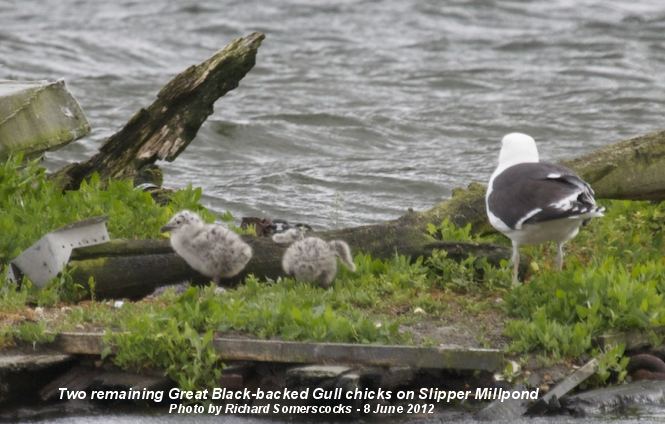
Brook
Meadow
Richard Somerscocks
went over to Brook Meadow late this afternoon. Still a
bit windy for butterflies but there were a few around,
including a couple of Red Admirals, a Common Blue and
also two Large Skippers - the first of the
year.
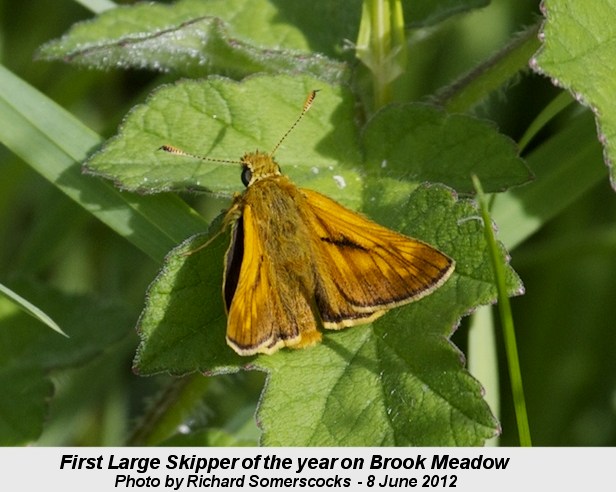
One was on the Orchid
area and the other just to the south. Other insects on
the south meadow included Azure and Large Red
Damselfly and also a Broad-Bodied
Chaser.
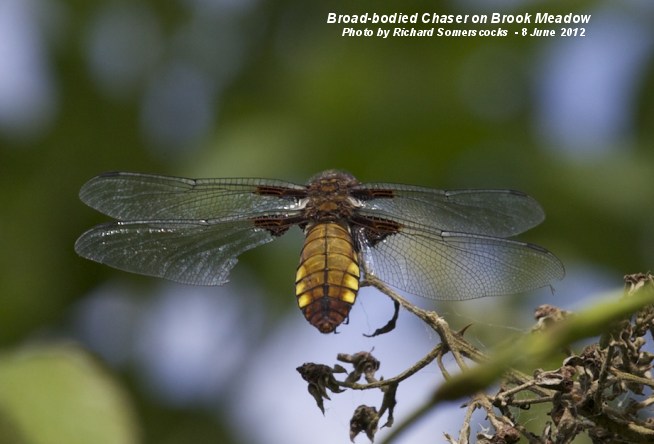
The 10 Southern
Marsh Orchids were showing well. In contrast, the
Common Spotted Orchids were flowering but looked weak.
They are crowded out by grasses and the wet and windy
weather doesn't help.
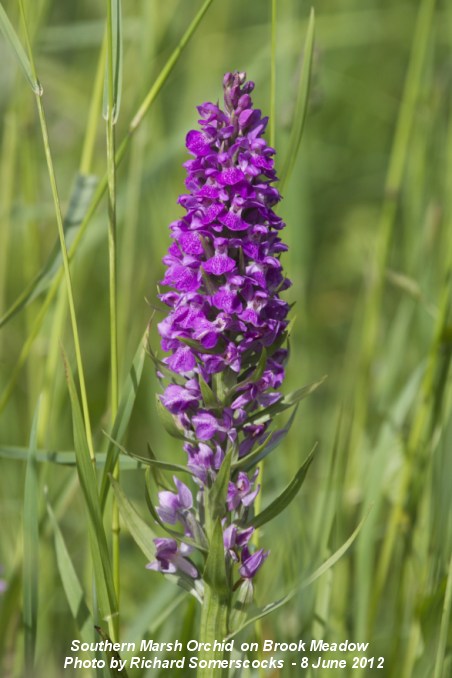
Pavement
grasses
I had another good
look at the two grasses on the pavements which were
identified by John Norton and Eric Clement when they
visited Emsworth last Monday. Water Bent is an
upright grass with a an open reddish inflorescence.
Fern Grass is low growing in a rosette fashion
with reddish stems and a one-sided inflorescence.

PRINSTED
This afternoon Jean
and I had a walk along the lane from Prinsted to
Thornham Lane. The Alpacas have now gone from the
field opposite Thornham House.
Mystery
grass
I was puzzled by a
couple of grasses with grossly distorted
inflorescences growing along the edge of the lane. I
picked one to have a close look at home. The presence
of an apparent bract extending past the inflorescence
suggested a rush of some sort, but the spikelets were
clearly fescue-like. As Tall Fescue was growing nearby
I assume this is what it was.
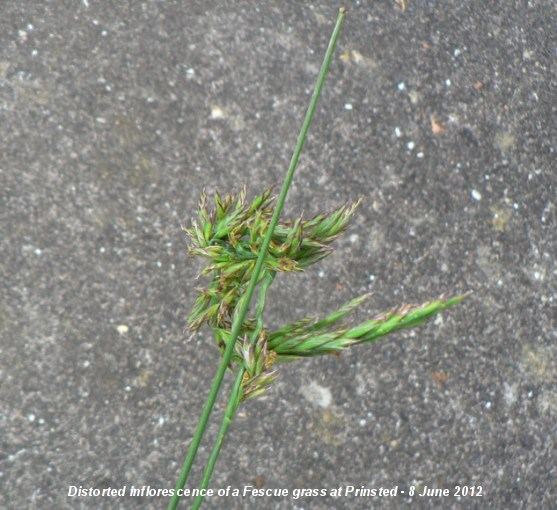
Rough
Chervil
I was pleased to find
plenty of Rough Chervil in flower along Thornham Lane
- my first of the year. Rough Chervil is like Cow
Parsley, but flowers later and has a rough stem with
purple blotches, a feature which is shared only by
Hemlock, though that plant is much taller than Rough
Chervil.
THURSDAY
JUNE 7 - 2012
CHICHESTER
Chichester
Peregrines
We had planned to go
over to the Isle of Wight today, but the weather was
so dreadful that we abandoned that plan. Instead we
had a morning browsing around the shops in Chichester.
While we were there I popped into the RSPB booth at
the Cathedral - now located on the grass in front of
the cathedral. They had a telescope trained on one of
the male youngsters perched on a turret. The volunteer
told me at least two of the birds were regularly
making short flights, though they would not be able to
fend for themselves until the end of September.
I asked him about the
Peregrines nesting on the church in Bath as shown on
Springwatch where one of last year's juveniles had
been taking part in the brooding and feeding of the
chicks. He said this had never occured at Chichester
though it was not unusual to see juveniles from
previous years around the nesting site. They were
always driven off by the parents.
Interestingly, the
volunteer told me about an occasion when one of the
adult Peregrines brought down a Buzzard that was
flying too close to the nest. The Buzzard was so badly
injured it had to be taken to the Brent Lodge Bird
Hospital!
Chichester
Walls
I had a short walk
around the walls before the rain set in. I noted the
following new plants in flower; Hedge Woundwort,
Common Knapweed, Oxford Ragwort, Tufted Vetch.
EMSWORTH
Slipper
Millpond
17:00 - Both Great
Black-backed Gulls were on the centre raft. The chicks
were not visible, probably sheltering in amongst the
vegetation from the strong winds.
Peter
Pond
I am fairly sure a
pair of Coot is nesting on the new floating raft on
Peter Pond.
Brook
Meadow
Birds singing on the
meadow this afternoon included Blackbird, Blackcap,
Chiffchaff and Song Thrush.
Common Comfrey is
flowering well around the meadow, some plants with
white flowers and others with purple-pink ones.
Yorkshire Fog is now showing its attractive pink
tinged spikelets around the meadow. Reed Canary-grass
is also showing its tall spikelets for the first time.
I shall need to check the Soft Bromes for Smooth
Brome.
WEDNESDAY
JUNE 6 - 2012
EMSWORTH
Slipper
Millpond
09:30 - Both Great
Black-backed Gulls were on the centre raft with
the female sitting on the nest and the male standing
nearby. I could just make out the chicks but they were
sleeping. While I was watching, the male gull went
onto the water and the female went around the raft
collecting small pieces of vegetation which it placed
on the nest. It seemed to be nest building even though
the eggs and chicks were not there.
A Little Egret arrived
on the raft, but was quickly seen off by the female
gull. All three nest boxes on the pond rafts are still
occupied by Coot.
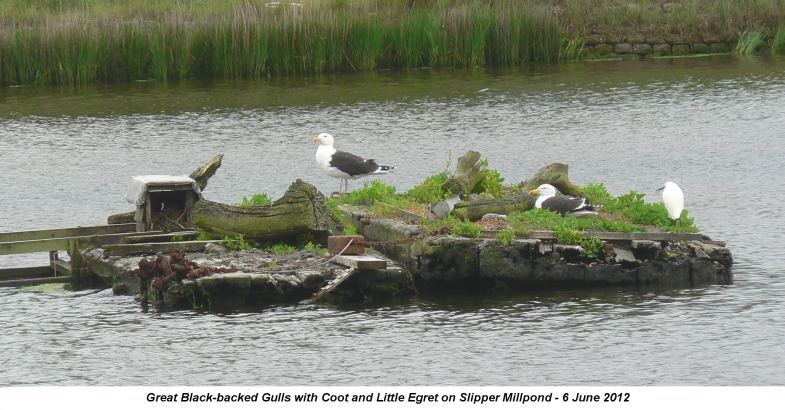
Brendan Gibb-Gray told
me he saw all three chicks yesterday moving around on
the raft. They appreciated naan bread which he tossed
into the water. The Mallard duck is still sitting on
the nest on Brendan's patio.
Garden
Bullfinches
This afternoon at
about 3pm we had a male-female pair of Bullfinches on
the feeding station and the bird table for abouit 10
minutes. This gave me the chance to take a few photos
through the window. They were the first Bullfinches
seen in the garden since July 2008.

TUESDAY
JUNE 5 - 2012
EMSWORTH
Slipper
Millpond
09:30 - Both Great
Black-backed Gulls were on the centre raft. The female
was snoozing on the nest, probably protecting her
three chicks from the very cold easterly wind blowing
across the pond. The male bird was also snoozing.
Coots were occupying
the nest boxes on the three rafts, probably for a
second brood. All chicks from the first broods have
been lost.
A Mediterranean Gull
was on the pond, the first I have seen there for a
while.
Peter
Pond
David Gattrell is in
the process of cutting out a new channel through the
reedbeds for the Lumley Stream as it flows into Peter
Pond.
A Coot may be nesting
on the new floating raft in the centre of the pond.
LANGSTONE
HARBOUR BREEDING REPORT
Chris Cockburn reports
on what is looking like a poor breeding season in
Langstone Harbour for the nesting gulls and terns.
"At the Oysterbeds,
the extremely high density of gull and tern
territories is causing problems, with small chicks
often straying into adjacent territories and suffering
the inevitable consequence of being attacked by the
neighbouring adults. These problems are being
heightened by the current series of very high spring
tides, during which birds are forced into
diminishingly small areas. Many of the Black-Headed
Gull nests that were rebuilt after the May spring
tides have been flooded out again and the local crows
have enjoyed feasting on the eggs that were washed up
on the shorelines.
Approximately half of
the c20 Common Tern nests have been flooded out; but
they were all at the egg stage, so there is a chance
that the re-lays will be more successful. No Sandwich
terns are presently nesting here.
As for the RSPB
islands, it has not been possible use the boat to
monitor the gulls and terns on the islands; but there
are strong indications that many of the Mediterranean
and Black-Headed Gull nests on the saltmarsh areas
have been flooded out, Likewise, many of the
shingle-nesting Common Tern and (of course!) Little
Terns will need to re-nest.
The very high spring
tides are likely to continue until Thursday and if
long periods of rainfall continue, chicks will be at
additional risk of suffering hypothermia.
Unsurprisingly, insect
numbers are low while vegetation is burgeoning. The
summering flock of Bar-Tailed Godwits that are
roosting on Stoke Bay Spit is a pleasant bonus (47
birds recently).
Hopefully, the weather
will soon change to give a prolonged spell of gentle
winds and sensibly warm seasonal
temperatures..."
MONDAY
JUNE 4 - 2012
EMSWORTH
Slipper
Millpond
10:30 - Both Great
Black-backed Gulls were on the centre raft when I
arrived, but I could only see one chick. However, the
other two chicks showed themselves after a few
minutes. Interestingly, the chicks were pecking the
red spot on the parent's mandible to stimulate
regurgitation. The gull family had the company of the
Coot nesting in the nest box on the raft.
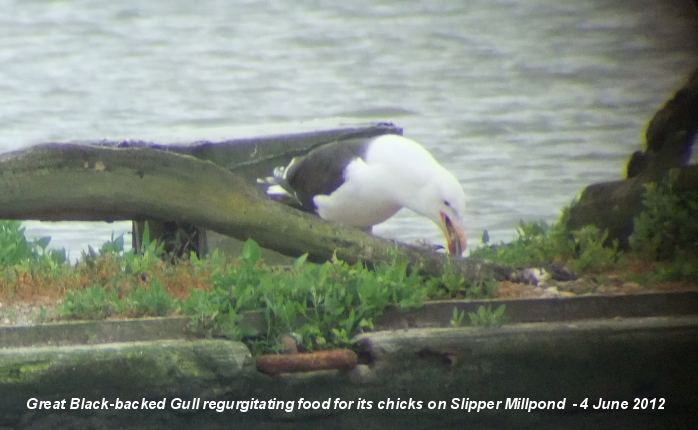
The Coot pair from the
north raft were alone on the pond and appear to have
lost their remaining one chick, probably down the
throats of the large gulls.
BROOK
MEADOW
Beautiful
Demoiselle
Malcolm Phillips
captured this excellent image of a Beautiful
Demoiselle damselfly on Brook Meadow on Saturday June
2. Beautiful Demoiselle is a far less common damselfly
on Brook Meadow than the familiar Banded Demoiselle.
It was first recorded on the meadow in 2008 and was
seen again in 2010, but not at all last year. So it is
good to know it is back with us. The male differs
mainly in the having pure blue wings without the dark
band of the Banded Demoiselle.
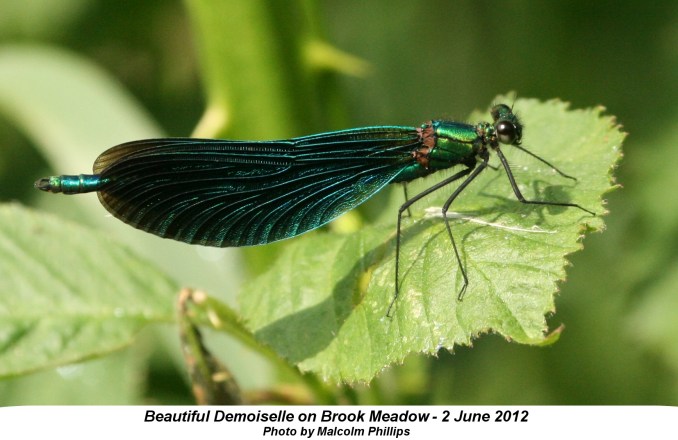
BOTANISTS
VISIT EMSWORTH
John Norton and Eric
Clements (botanists from the BSBI) along with local
naturalist Ralph Hollins, visited Emsworth this
afternoon. I was pleased to accompany them around a
few sites. They started in Bridge Road car park
wayside and walked up Victoria Road to Brook Meadow.
Bridge
Road Wayside
Two new plants were
discovered on the Bridge Road Wayside, Common Vetch
flowering near the Goat Willow and Stone Parsley (not
flowering) on the east bank of the stream near the
Bulrushes. These take the total list for the site to
172. Plicate Sweet-grass is also out in the Westbrook
Stream near the Bulrushes, taking the total for 2012
to 112.
Brook
Meadow
Three new plants were
found for Brook Meadow, taking the list (excluding
bryophytes) to 338. Wych Elm tree on the east bank of
the Lumley Stream opposite the small path to the
stream from the Lumley area. Common (not Early)
Wintercress flowering on the east bank of the river
opposite the observation fence.
Best of all, was
One-glumed Spike-rush or Slender Spike-rush
(Eleocharis uniglumis) - a patch on the west side
of the Lumley area about 10 metres from the cross
path. This is a good plant to have as an indicator of
saltmarshes.
John
Norton inspecting the Slender Spike-rush with Ralph
Hollins while Eric Clement examines some
grasses

Other plants noted:
Beaked
Hawk's-beard confirmed as flowering outside the
Seagull Lane gate. Common Fumitory was confirmed on
the Seagull Lane patch. Festulolium Hybrids
south of the seat on the east side of the north
meadow. Square-stalked St John's-wort on the Lumley
area. Japanese Honeysuckle in flower by the
Lumley gate. Water Forget-me-not flowering on the east
bank of the river north of the south bridge. Blue
Water Speedwell growing north of the Forget-me-not
on the east side of the river. Toad Rush flowering
near the "Lumley puddle". The leaves of Giant
Fescue are shining brightly beneath the south
bridge.
John provided a useful
tip for distinguishing the Pond Sedges. Lesser
Pond Sedge has longer ligules than Greater Pond Sedge
which has shorter blunt ligules. Most of the Pond
Sedges near the Lumley copse were Greater, though John
did find one example of Lesser. I usually find Lesser
Pond Sedges on the banks of the River Ems.
Other
observations
Water Bent
(Polypogon viridis) was found growing in a
crack in the pavement outside house number 24 Victoria
Road and in the driveway of 38 St James Road.
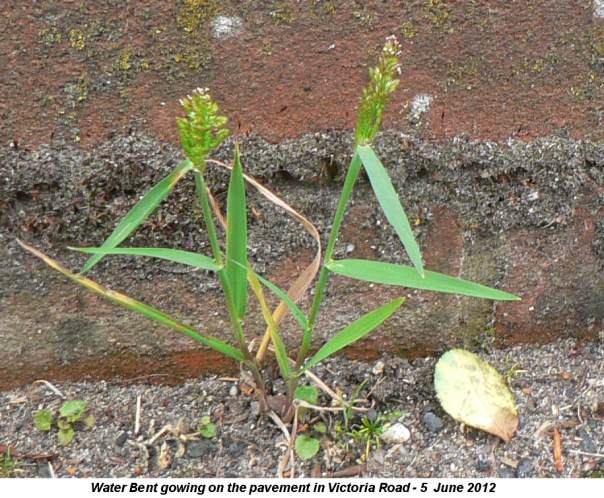
Fern Grass
(Catapodium rigidum) was discovered on the
pavement outside number 38 St James Road and in the
driveway of number 35 St James Road. This is a native
species often found in thin bare well drained soils as
in pavements. Common in the South of England.
Keel-fruited
Cornsalad was confirmed outside house number 34a
St James Road.
OTHER
NEWS
Caroline and Ray
French Ray drove past Chichester today and there were,
at a very rough guess, about 200 Swifts above the
Westhampnett lake area. Why aren't they coming to
Emsworth?
SATURDAY
JUNE 2 - 2012
EMSWORTH
Great
Black-backed Gulls
11:00 - I checked on
the Great Black-backed Gulls nesting on the centre
raft on Slipper Millpond this morning. The female was
with the three chicks which were huddled beside her.
After a few minutes the male bird came in with food
which it regurgitated for the chicks. The female went
off herself.
The Coot family from
the north raft has lost one chicks since yesterday,
possibly taken by the gulls. So they are now down to
one. However, the Coot remains entrenched in the nest
box on the centre raft with the gulls.
FRIDAY
JUNE 1 - 2012
EMSWORTH
Great
Black-backed Gull nest
09.30 - The Great
Black-backed Gull was sitting on the nest on the
centre raft when I arrived, but after about 5 minutes
she stood up to allow the chicks to move around. I got
a good view of them and can confirm there are
definitely three spotty chicks.
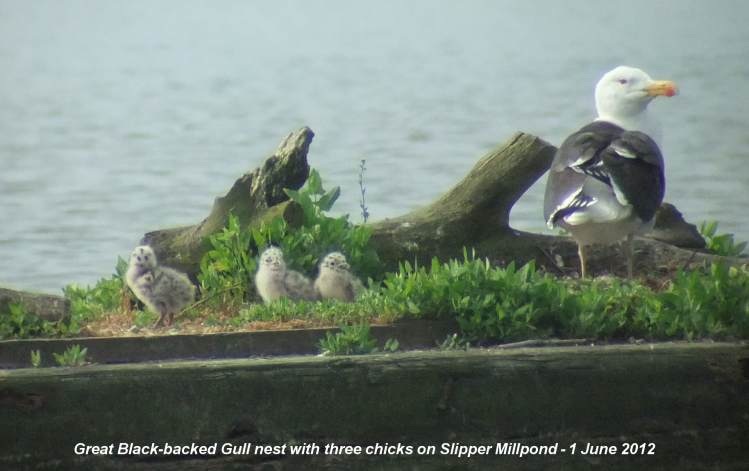
17:00 - When I arrived
the female was on the nest, but constantly calling and
looking around presumably for her mate. The male
arrived after about 5 minutes and proceeded to
regurgitate food for the chicks.
Coots
The Coot was back in
the nest box on the centre raft, presumably for a
second try. The Coot family with two chicks from the
north raft was on the pond near Chequers Quay.
Bridge
Road Wayside
I was pleased to find
to striking yellow flowers of Sulphur Cinquefoil
on the grass verge, close to where they were first
seen last year, though not until July! There is a good
growth of False Fox Sedge around the Wild Flower
Conservation Area notice. Yellow Flag was flowering
well on the verge south of the Goat Willow, a new
plant for this wayside. Meanwhile, flowering beneath
the Beech hedge were Lesser Swine-cress, Wall Lettuce,
Wall Barley, Smooth Sow-thistle, Broad-leaved
Willowherb, Wall Speedwell, Dog Rose, Bramble and
Honeysuckle. The leaves of Narrow-leaved
Water-plantain are growing near the Bulrushes in the
stream, but no flowers as yet. The grand total for
this wayside now stands at 170 species with 109 having
been found so far this year.
For
earlier observations go to . .
May
2012 (17-31)